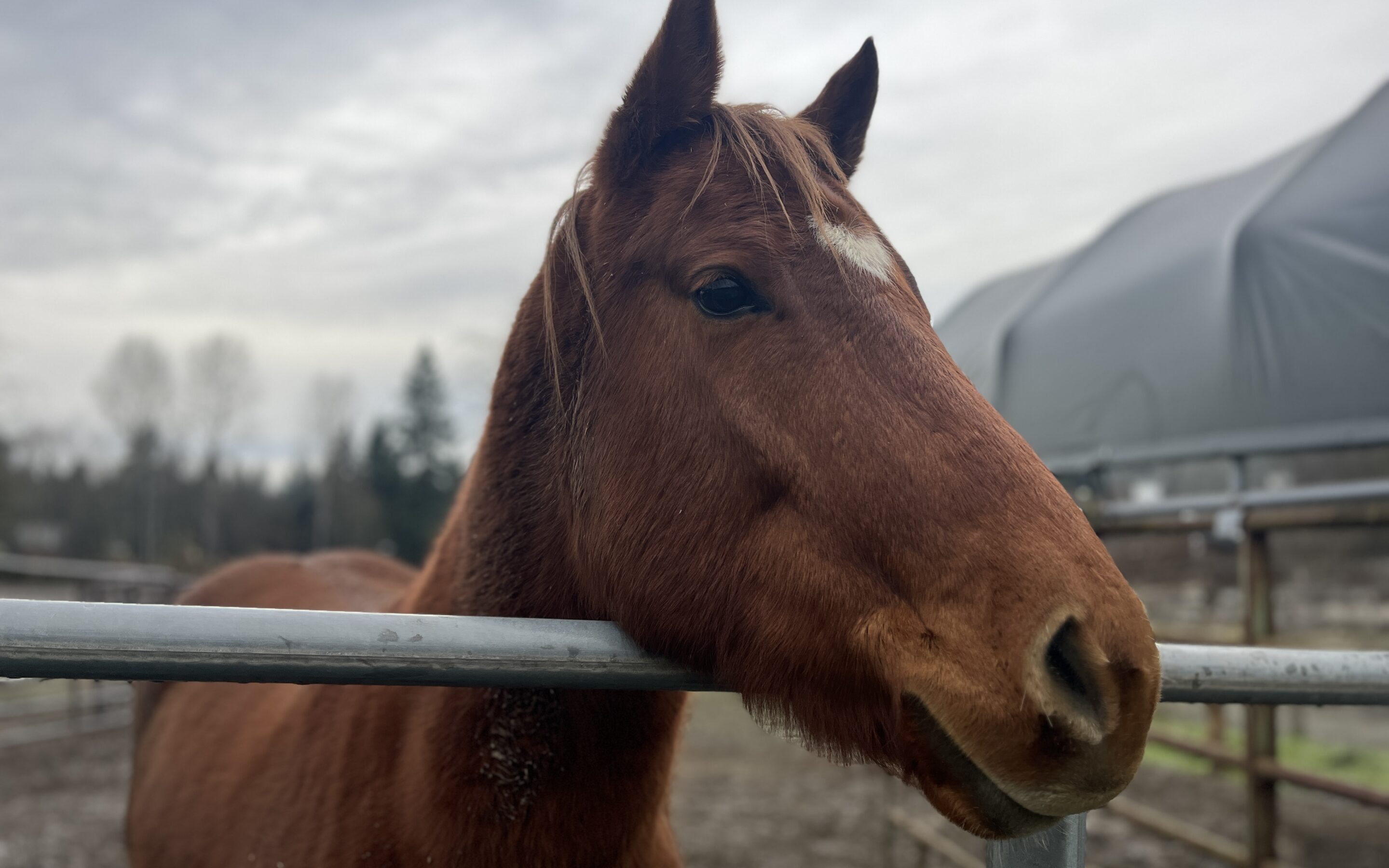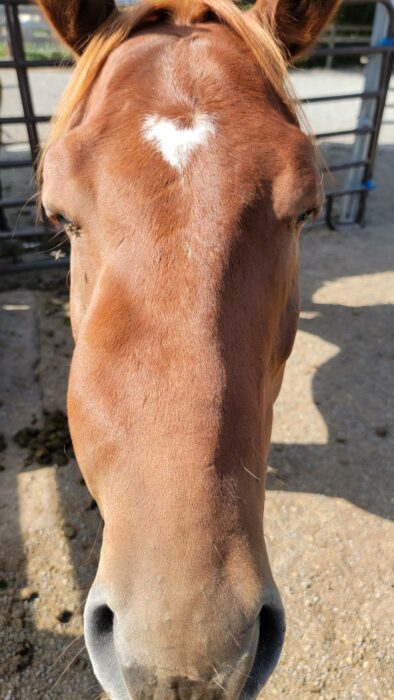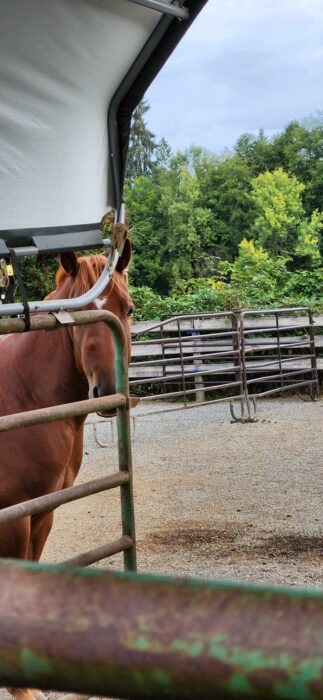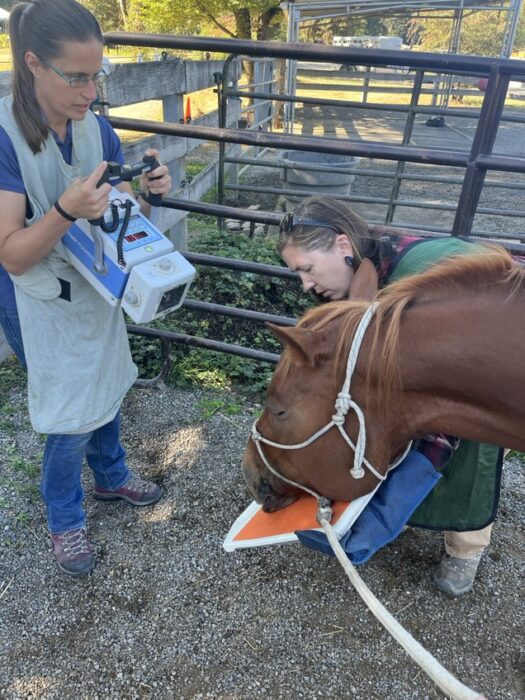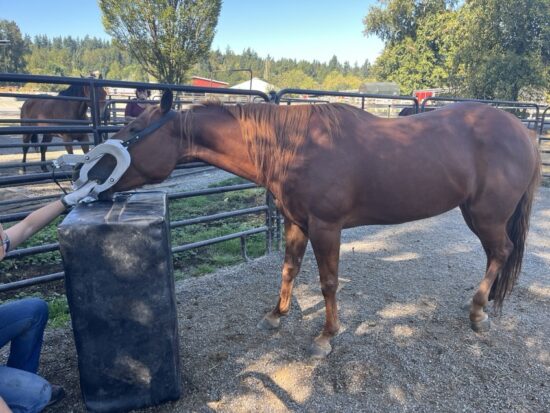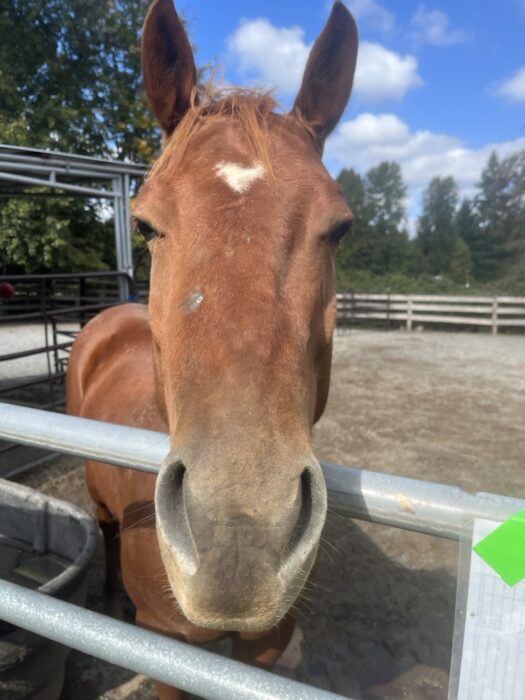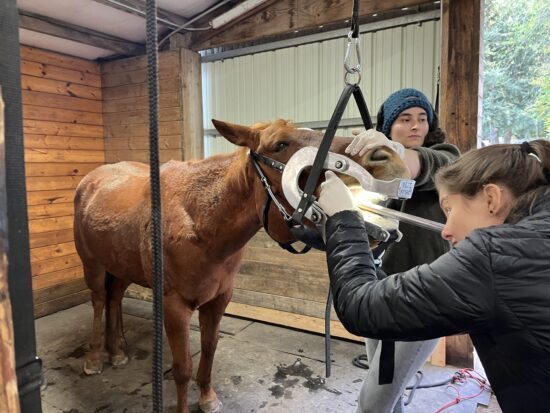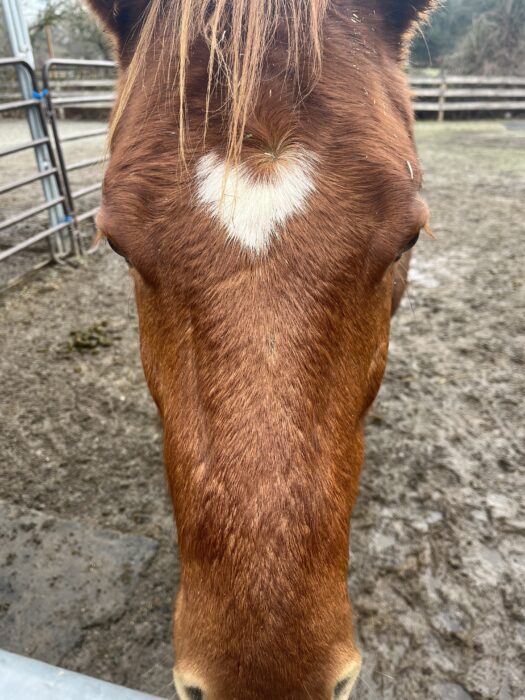Imagine, for a moment, a slightly better than worst-case scenario that might occur at a horse rescue. Your mind probably jumps to something medical, right? Nothing life-ending (that would be more on the worst-worst-case scenario side) but something dramatic enough that there are some elevated cortisol levels associated with the event. What about something like a mostly untouchable horse who develops an ailment that needs to be seen to? One requiring X‑rays and many vet appointments? If you need help envisioning a scenario, let me regale you.
It began with a bump.
It was the end of August, and the days were still long. Daylight extended past the 6 o’clock hour, and the afternoon chore teams did not yet have to work under the cover of darkness. Golden hour shined down on Harissa, who illuminated like a new penny under the glow of the sun. Like a spotlight, the sun also showed a new addition to her face — a rather large lump. The right side of her face, between nose and eye, distended out like a twisted roman nose. She was still eating well, perhaps not as voraciously as usual, but in a way that didn’t cause a significant amount of concern. For all intents and purposes, she was behaving normally. We gave her a gram of bute for the swelling, and planned to check on her in the morning.
The bute didn’t touch it. Each day, Harissa would greet us with the same level of enthusiasm for her morning meal, the swelling on her face an unwelcome visitor who didn’t seem to be departing any time soon. It was a Friday evening when all of this began (the preferred time for horses to require medical attention: after hours) but throughout the weekend she behaved just as she always had. No change in diet, no new lethargy or unusual habits, no nasal discharge. But the swelling did not go down.
We called the vet first thing Monday morning. Their treatment suggestions mirrored those we had been using: bute. They said it could be either trauma related or something to do with a tooth, and that if she wasn’t having trouble eating, we were okay to monitor it as we worked to get our hands on her. We were reminded of Otto, whose infected tooth caused a similar facial lump. We crossed our fingers that would not be the case for Harissa, and held out hope that it would somehow resolve on its own. As if!
For while Harissa posed prettily for our daily update photos, she still had only a minor amount of handling. It was not uncommon for her to lunge at the individuals hanging her hay net, and even if that wasn’t the case, we had seen her degree of unpredictability first hand. She had yet to have a dental float, and her only time outside her paddock had been spent in the attached round pen, learning the basics of giving to pressure. She was not what we would consider to be halter broke, the list of tools she had to talk her out of trouble able to fit on a post-it note. The thought of leading her into the barn, sedating her for a float, having our vets put a drill in her mouth… all seemed still out of reach. At least, out of safe reach. But this facial swelling was stubbornly set on staying, and while it did not seem to be impacting her quality of life, the waiting game was over, and we had to take action.
Ahead of said action, as if to hurry us along, a secondary bump appeared atop the first one. Things were, quite literally, coming to a head. The vet was able to make it out in a few days, and we discussed a game plan on what we would attempt and how we would attempt it (starts with Dorm and ends with gel). Meanwhile, Harissa continued to eat and drink as normal, though we monitored her closely for any changes.
The next day, a welcome, if not slightly stomach-churning sight: the abscess that had formed the previous day had blown, leaving an unsightly trail of drainage, a little river over the hill of her face. She allowed us to clean her up a bit, but there is only so much poking and prodding of the area we wanted to do. There had to be a degree of relief associated with the expulsion of some pressure, and we eagerly awaited the vet’s opinion.
Harissa needed X‑rays to see what exactly was happening beneath the hood. While they have come a long way X‑rays do require a source of power in order to view the images. Harissa’s paddock was not near a power source, and the nearest outlet did not generate enough juice via extension cord to run the machine (ask us how we know). So Harissa would have to move closer to the power. Ideally, this would look like bringing her inside the barn, but like previously mentioned, her ability to lead was very minimal, and adding in the element of a totally new environment on top of an already stressful situation did not feel like the right move. Instead, we did a bit of musical horses, for there sits a row of paddocks that are easily accessed by an outlet, and where we felt would be a good spot to work, quite literally, in the field.
But this didn’t solve the issue of moving Harissa, which would still have to be done, even if it wasn’t as far or as intimidating as the barn. Over the days leading up to the vet visit, we had been spending more time with Harissa, if only just to halter her and get her used to the idea of leading around a bit. This was all happening when Terry, who has the most experience with difficult horses outside of Joel, was away on vacation, which was also a complicating factor. But while Harissa wasn’t overly keen on the idea of being haltered, she did not snap or strike at us, even while we washed her face or gently palpated the area to feel for heat. It did something to boost our confidence. But still, the leading outside her paddock aspect left many variables open. If she were to pull away, either as a result being spooked or through her own decision making, there was a chance she would not let us catch her again. This was just one of a few worst-case scenarios the pessimists in us dreamt up in the days ahead of her appointment.
Our vets recommended a light sedative to begin her day, some trazodone in a handful of grain about an hour ahead of the appointment. By the time we went out to get her, Harissa was napping in the sunshine, cool as a cucumber. The second part would be dorm gel, a tricky medicine to administer to even the best of horses due to its need to be given under the tongue. Sleepy Harissa, for whom the trazodone had done a wonderful job of taking any initial edge off, was patient with us as we sought that under-tongue sweet spot (it perhaps didn’t hurt that we dipped the tip of the syringe in molasses first). Then, after the time needed to get both dorm and trazodone on board, Dr Lewis entered the scene with a little dose of IM sedation. Yes, Harissa had modern medicine on her side that day to help her handle any anxieties, but something we have since learned is that she likely did not require all that fanfare for a needle — she is completely reasonable when it comes to shots.
But I’m getting ahead of myself. The sedation would be needed for the X‑rays and for any subsequent probing that might happen, but it would also greatly assist us in our walk. We weren’t going quite across the property, but far enough that any help was welcome. We also brought out Ciara, Harissa’s friend and neighbor, to accompany us on the journey, the brave engine to Harissa’s little red caboose.
Despite the sedation, it was clear that Harissa was jazzed to be outside of her paddock, even with the friend accompaniment. But we took things slow, and made it safely to our destination with relatively little fanfare. Once there, we could get to the real crux of the issue.
Sedation and Harissa are a good match. Nothing about the bustle of the vet, even as she poked and prodded the area, stirred Harissa to any sort of action. Dr Lewis used a big foam block set on its side to rest her face upon, and Harissa relaxed into this pillow with immediacy. From there, she shot X‑rays, and even took a peek in her mouth to see if there was anything visible from the oral side of things. Unfortunately, results were not particularly revealing. It can be difficult to view X‑rays in the field, but obvious things typically appear. However this day, nothing jumped out at Dr Lewis as a clear cause, and her mouth looked normal from the cursory investigating she did, all teeth in their proper place. Dr Lewis took the time to help expel some of the residual gunk that remained in the abscess port, and flushed it out to clean it. It was something to behold for fans of shows such as Dr Pimple Popper, but for those who are skeeved out by that sort of thing, it was slightly nauseating.
Drunk on sedation, we walked Harissa back to her paddock to sleep off the rest of the drugs in the sunshine.
We would try Harissa on a course of SMZs to see if it would bring the swelling down. Dissolved and poured over a bed of Purina senior, Harissa had no issue eating the meds, a fact we were very grateful for. The metronidazole that might typically accompany a course of SMZs was withheld — haltering Harissa was one thing, but rectal meds quite another.
Time passed, and the antibiotics were making an impact. The swelling was decreasing, and the hole from the abscess port was healing. A closer look at the X‑rays showed there was a slight tooth root abscess that was likely the cause of the issue. To remove a tooth, especially one that is otherwise healthy looking, is an intense procedure, and not something that is done lightly. The ideal scenario would be to see if the long course of antibiotics could prevent us from having to take bigger action.
6 weeks later, Harissa had her first dental.
This time, she would come into the barn.
Joel had visited in the time between, and had worked on leading Harissa around the property. She took trips to the arena, walked through the barn aisle and spent some time in a stall. So this would not be her first rodeo, but there were still elements of uncertainty involved.
We used the same tactic as last time when we moved her into another paddock: trazodone, friend support. We prepped a stall with a half-wall for her and her buddy to chill out in before the procedure. Aside from a little bit of initial antics, the walk in to the barn was mostly uneventful, and once in the stall, she quietly munched hay. We did give her another tube of dorm, although it hadn’t quite fully set by the time the vet was ready to see her, and once again, she did great for IM sedation.
Her dental showed sharp points, but nothing about that tooth that was worrying. Her mouth looked healthy as a horse, and were it not for the still-present lump, there would have been no concerning signs. Because the antibiotics were working so well, we would keep her on them for another two weeks, and reevaluate with another set of X‑rays at that time.
8 weeks since she began the SMZs, and once again we walked Harissa to the barn for X‑rays. This time, we did not dorm her for the sedation. We were all getting the hang of things!
This follow-up did show a decrease in the size of the fluid pocket above the tooth, but its presence was still a bit concerning to Dr Lewis. We would keep her on SMZs for another month and take yet another set of X‑rays and make a decision on what to do then. At this time, her face looked bilaterally pretty normal, the majority of the swelling was gone. To look at her, you wouldn’t necessarily know that just several weeks back she had a completely different topography.
Then, almost 16 weeks from the time the lump on Harissa’s face first appeared, we reached a turning point. We took a third (and hopefully final) set of X‑rays. While not entirely gone, the fluid pocked was even smaller than the time prior. Dr Lewis decided that it was time to try her off the antibiotics to see if she could maintain that beautiful symmetrical face without them.
And since that date, just a few weeks ago now, Harissa is doing great. There is still a very light amount of swelling in the area, but one that our vets said was normal, as soft-tissue ailments can take a while to come down.
For a mare who was in many ways a complete (and potentially dangerous) wild card, Harissa showed us so much grace during this entire multi-month process. From allowing us to dorm her and poke her and lead her into new and unfamiliar situations, she did a wonderful job at not only being tremendously brave, but also very kind. And in return, we were able to help her feel better and get her the assistance she needed. Now, our wish for the new year? That Harissa doesn’t have to see an X‑ray for a long, long time!

